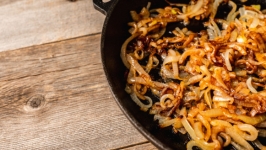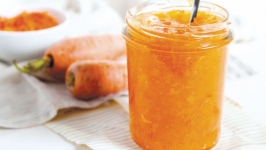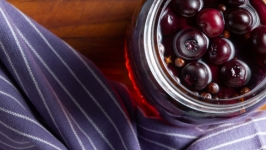Instructions
When our short growing season gives in abundance, you say thanks and run with it. Preserving produce is a great way to extend its shelf life into the colder months and it helps save a few dollars — you won’t have to throw anything out and you can buy in bulk when it’s less expensive. Canning at home doesn’t need to be a daunting or intimidating process. With a couple of pieces of equipment and a few guidelines, you’ll be able to amass your own collection of preserved provisions like a pro.
Quick pickling is an easy way to get started. Because of their high acid, sugar and salt content, the following recipes can be used as “quick pickles” without the hot-water processing required for long-term storage. These jars can be kept in your refrigerator for up to a month.
Really in a pinch for time? Freezing produce at the peak of the season is an even quicker way to save the taste of summer. Wash and dry fruit and vegetables before spreading them out on a baking sheet, so they're not touching each other, and freeze them. Once frozen solid, put them in air-tight containers and store them in the freezer for up to three months. Make sure to label them so you can remember the date of processing. Want to graduate to filling your larder for the winter?
Follow Health Canada's home canning safety guidelines (www.canada.ca/en/health-canada/services/general-food-safety-tips/homecan...) and Bernardin's step-by-step instructions with photos (bernardin.ca). For a list of preserving workshops in the region, visit edibleottawa.co/things-do. Whether quick pickling or preserving for long-term storage, start by using a current and tested recipe. Choose fresh, high-quality ingredients and wash the produce before you begin. And it's always a good practice to start with clean, sterilized glass jars and new, sterlized seals and lids.
Jardinière Makes about 6 cups
The jardiniere is a pickle of mixed vegetables from the garden, as the name would suggest. Salting the vegetables first will draw out much of the moisture, improving their texture, while keeping any bacteria at bay.
2 cups cauliflower
1/2 small fennel bulb
1 small onion (yellow or red)
1 large carrot
1 medium red pepper
1 medium patty pan (or yellow zucchini)
3 to 4 small chillies
3 tablespoons kosher or coarse sea salt
4 cups cider vinegar
4 tablespoons sugar
1/3 cup herbs such as sage, fennel fronds and cilantro flowers
salt
On a clean cutting board, cut all vegetables into small, bite-sized pieces and place in a bowl with whole chillies (cut the chillies in half if you like it spicier) and sprinkle liberally with salt. Cover the bowl with a towel or plastic wrap and let stand 4 to 6 hours, stirring occasionally.
After 4 to 6 hours, drain vegetables and cover with fresh, cool water. Repeat this process of draining then rinsing with fresh water 3 to 4 times until the strong salt taste has been removed. Drain well and pat dry.
In a saucepan over medium heat, dissolve the sugar in the vinegar. Reserve.
Place the vegetables into sterilized jars, mixing in your favourite washed herbs, such as sage, parsley and cilantro. Pour in the vinegar until the vegetables are fully submerged, leaving at least a quater-inch air space at the top of the jar. Seal and process.
Pickled Gold Beets Makes 4 cups
4 to 5 medium-sized gold beets
2 cups white or cider vinegar
1/2 cup sugar
1 tablespoon salt
2 teaspoons coriander seed
1 teaspoon turmeric
5 to 6 small stems Thai basil, leaves, stems and flowers
Place beets in a pot and cover with water. Bring water to a boil and turn the heat down to medium-low and cook beets until just cooked in centre. Remove the beets from the water and allow to cool until you are able to handle them and remove the skins. Once peeled, cut the beets into about 6 pieces, either wedges or disks.
In a saucepan, bring the vinegar, sugar and salt to a boil and then simmer until completely dissolved. Reserve.
Fill sterilized jars with beets, coriander seed and Thai basil. Cover with the vinegar brine until beets are covered. Store in the refrigerator for up to three weeks.
Fire-Roasted Corn Relish Makes 4 cups
3 cups corn
1 cup yellow onion, finely diced
1/3 cup red pepper, small dice
1/3 cup sugar
1 1/2 cups apple cider or white vinegar
2 teaspoons mustard seed
1 teaspoon fennel seed
1/2 teaspoon turmeric
2 tablespoons parsley, chopped
2 teaspoons fresh sage, chopped
1 tablespoon oil
2 tablespoons cornstarch
1 to 2 teaspoons salt
a pinch of pepper to taste
Remove husk from 5 to 6 cobs of corn. Place corn onto a hot grill and cook until the corn takes on some dark spots. Remove from grill and cool. Cut the kernels off the cob and reserve.
In a saucepan over medium-low heat, add oil and onions and sweat until soft and translucent. Add red peppers and cook for 4 to 5 minutes until peppers start to soften. Add grilled corn. Turn heat up to medium and add sugar, vinegar, mustard seeds, fennel seeds, turmeric, remaining 2 teaspoons of salt and a pinch of pepper.
In a small dish, mix cornstarch with about 1 tablespoon of cold water. Add to relish and bring to a boil. If at this point the mixture still looks a little watery, feel free to add a bit more starch.
Remove from heat. Add parsley and sage, then spoon directly into sterilized jars.
Pickled Asparagus
3 bunches of asparagus, approximately 24 to 30 spears
2 cups cider vinegar
1 cup water
1/2 cup sugar
1 teaspoons each, mustard seeds, chili flakes
1 bunch fresh dill
2 cloves garlic, minced
2 tablespoons salt, kosher is best
Snap the bottom of each spear of asparagus to remove the woody ends. Fill sterilized glass jars with spears, herbs, garlic and your choice of spices, leaving an inch of head space to completely cover the asparagus with the brine.
Prepare the brine. Bring the water, vinegar, sugar and salt to a boil, reduce the heat and simmer until the sugar and salt have dissolved, approximately 3 to 4 minutes. Pour the hot liquid into the jars, completely covering the asparagus. Store in the refrigerator for up to three weeks.
Use the same brine to make quick-pickled red onion. Slice a medium-sized red onion into rings. Place into sterilized jars and cover completely with the brine and store in the refrigerator. Pickled onions are a great addition to sandwiches, tacos and barbecued meats.
Boozy Fruit
One of the oldest techniques for preserving fruit and vegetables, storing them in alcohol is also one of the easiest (and one of our favourite) methods. Whether making a firey vodka for the all-Canadian caesar or a fruit liqueur, this simple ratio will let you get creative with your cocktails, boozy-fruit desserts and sauces.
1 part alcohol, vodka, gin, whiskey
1 part fruit, herbs or peppers, washed and dried
Optional: If you'd like to sweeten the fruit infusions, add simple syrup (equal parts sugar and water brought to a boil and simmered until the sugar has completely dissolved), to taste.
Tomato Chutney Makes 4 cups
6 cups tomatoes
1 cup yellow onion, small dice
2 cloves garlic
1 cup sugar
3/4 cup white vinegar
1 teaspoons salt
2 tablespoons mustard seeds
1 tablespoon molasses
1/4 teaspoon chilli flakes
1 tablespoon oil
Cut the core from the fresh tomatoes and then score an X into the bottom, using a sharp paring knife. Drop the tomato into a pot of boiling water for about one minute or until the skin starts to split. Remove tomatoes from water and cool. Peel off the skin then cut the tomato into pieces (you can do a rough chop here, it will all cook down).
In a saucepan over medium-low heat add oil, onions, garlic and 1 teaspoon salt. Sweat until translucent. Add tomatoes and all remaining ingredients. Turn heat up to medium and bring to a boil. Reduce heat to a simmer and cook until mixture has thickened and most of the water is removed. This may take several hours depending on how juicy your tomatoes are to start.
If you prefer smooth chutney, you can add the chutney to a food processor and blend until smooth. You may also strain the chutney to remove the seeds.
Fill into sterilized jars. Store in the refrigerator.
Pumpkin Butter Makes 4 cups
1 medium-to large-sized pumpkin
2/3 cup brown sugar
1/2 cup apple cider (or apple juice)
2 tablespoons molasses
1 tablespoon cinnamon
pinch fresh nutmeg
Cut your pumpkin in half or into quarters. Remove seeds. Cook in 350F oven for 25 to 35 minutes or until soft. Once cooked, remove from oven and let cool. Remove skin from the pumpkin and add the meat to a blender or food processor. Blend until smooth then push through a fine-mesh sieve to remove any fibres or large pieces.
Add the puréed pumpkin and the rest of the ingredients to a saucepan and cook over low heat and cook until thick. As the mixture thickens, remember to stir more often to avoid burning.
Store in an airtight container for up to four weeks in the refrigerator. Enjoy on a graham cracker with sweetened cream cheese for a deconstructed pumpkin cheesecake.







